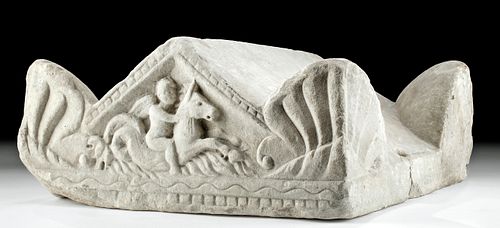Roman Marble Cinerarium Cover - Cupid Riding Hippocamp
Lot 44c
About Seller
Artemis Gallery
686 S Taylor Ave, Ste 106
Louisville, CO 80027
United States
Selling antiquities, ancient and ethnographic art online since 1993, Artemis Gallery specializes in Classical Antiquities (Egyptian, Greek, Roman, Near Eastern), Asian, Pre-Columbian, African / Tribal / Oceanographic art. Our extensive inventory includes pottery, stone, metal, wood, glass and textil...Read more
Categories
Estimate:
$10,000 - $15,000
Absentee vs Live bid
Two ways to bid:
- Leave a max absentee bid and the platform will bid on your behalf up to your maximum bid during the live auction.
- Bid live during the auction and your bids will be submitted real-time to the auctioneer.
Bid Increments
| Price | Bid Increment |
|---|---|
| $0 | $25 |
| $300 | $50 |
| $1,000 | $100 |
| $2,000 | $250 |
| $5,000 | $500 |
| $10,000 | $1,000 |
| $20,000 | $2,500 |
| $50,000 | $5,000 |
| $100,000 | $10,000 |
| $200,000 | $20,000 |
About Auction
By Artemis Gallery
Feb 13, 2020
Set Reminder
2020-02-13 10:00:00
2020-02-13 10:00:00
America/New_York
Bidsquare
Bidsquare : Exceptional Antiquities, Asian, Ethnographic
https://www.bidsquare.com/auctions/artemis-gallery/exceptional-antiquities-asian-ethnographic-4848
An important one-day auction featuring museum-worthy examples of Egyptian, Greek, Roman, Etruscan, Near Eastern, Far East / Asian, Pre-Columbian, African / Tribal, Oceanic, Native American, Spanish Colonial, Russian, Fossils, Ancient Jewelry, Fine Art, so much more! Artemis Gallery info@artemisgallery.com
An important one-day auction featuring museum-worthy examples of Egyptian, Greek, Roman, Etruscan, Near Eastern, Far East / Asian, Pre-Columbian, African / Tribal, Oceanic, Native American, Spanish Colonial, Russian, Fossils, Ancient Jewelry, Fine Art, so much more! Artemis Gallery info@artemisgallery.com
- Lot Description
Roman, Imperial Period, ca. 1st to 2nd century CE. A striking lid from a marble cinerarium, an urn for ashes as during this time it was common for Romans to cremate their dead (this practice would be replaced by sarcophagi and internment in the next century). The lid is in the shape of a temple roof, with a triangular pediment bearing a detailed relief image of Cupid (Eros) riding a hippocamp above what appear to be waves. Large shell carvings are at the corners, forming fan-shaped outlines around the pediment. A thinly incised, wave-like motif runs around the lower border of the pediment. Size: 11.5" L x 12.75" W x 5.9" H (29.2 cm x 32.4 cm x 15 cm)
Cupid is a common figure on Roman tombs, appearing in groups of cupids or alone, often sleeping, especially on children's graves. Portrayed as he is here, in flight on the back of a mythical animal, he creates a more dynamic memorializing image. The hippocamp is also a common figure on funerary sculpture. Why you ask? The sea was a major feature of Roman life, both connecting its people together and inspiring fear with its deep watery depths and hidden shoals full of unknown creatures. The Romans believed in a vast range of sea monsters who inflicted terror upon those brave enough to venture into the sea. Perhaps here the hippocamp and waves beneath it represent the unknown of the grave.
Provenance: private New York, New York, USA collection, acquired on the Paris, France art market in 2007; ex-private French collection
All items legal to buy/sell under U.S. Statute covering cultural patrimony Code 2600, CHAPTER 14, and are guaranteed to be as described or your money back.
A Certificate of Authenticity will accompany all winning bids.
We ship worldwide and handle all shipping in-house for your convenience.
#152679Repaired from two pieces. Stabilized area of repair on one side. Small losses from peripheries and the surface is lightly weathered with light deposits, but overall the details are well preserved and the artwork is clear.Condition
- Shipping Info
-
All shipping is handled in-house for your convenience. Your invoice from Artemis Gallery will include shipping calculation instructions. If in doubt, please inquire BEFORE bidding for estimated shipping costs for individual items.
-
- Buyer's Premium



 EUR
EUR CAD
CAD AUD
AUD GBP
GBP MXN
MXN HKD
HKD CNY
CNY MYR
MYR SEK
SEK SGD
SGD CHF
CHF THB
THB
















